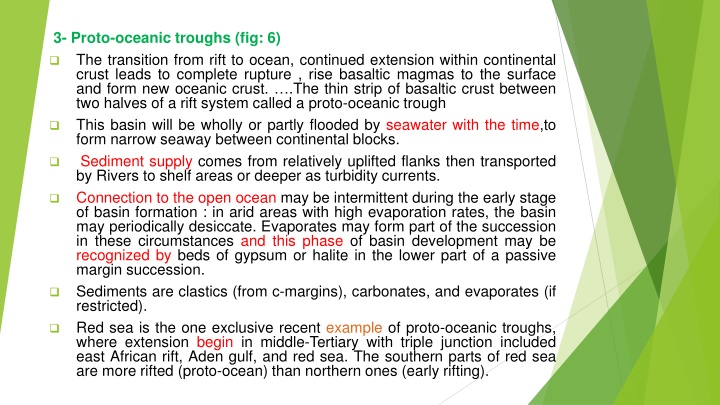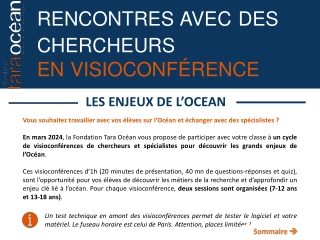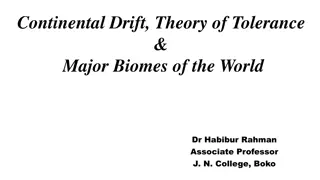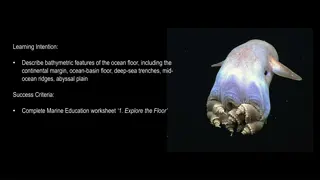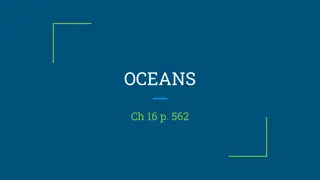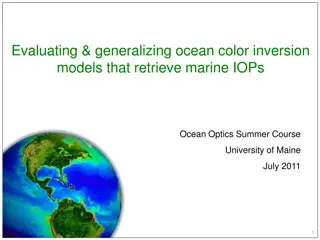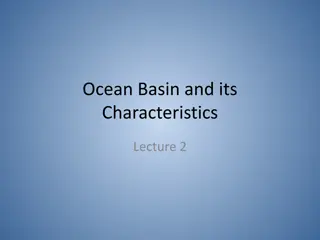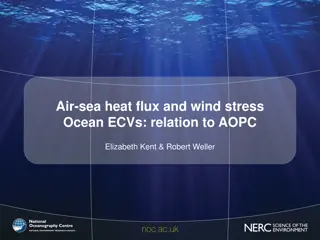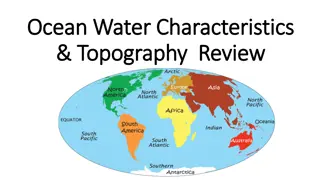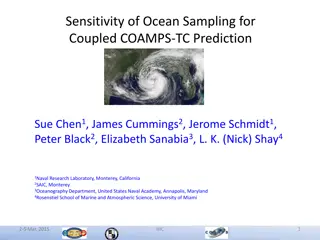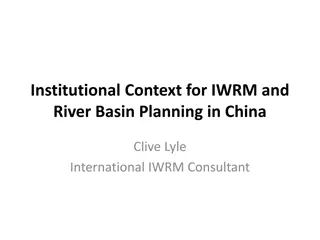Ocean Basin Formation and Continental Margins Overview
Ocean basin formation involves the transition from rift to ocean, forming proto-oceanic troughs and passive margins. Sediment supply, rift systems, and the role of tectonic processes in shaping these features are explored. The narrative delves into the unique characteristics of proto-oceanic troughs, passive margins, and ocean basins, shedding light on their formation mechanisms and geological significance.
Download Presentation

Please find below an Image/Link to download the presentation.
The content on the website is provided AS IS for your information and personal use only. It may not be sold, licensed, or shared on other websites without obtaining consent from the author.If you encounter any issues during the download, it is possible that the publisher has removed the file from their server.
You are allowed to download the files provided on this website for personal or commercial use, subject to the condition that they are used lawfully. All files are the property of their respective owners.
The content on the website is provided AS IS for your information and personal use only. It may not be sold, licensed, or shared on other websites without obtaining consent from the author.
E N D
Presentation Transcript
3- Proto-oceanic troughs (fig: 6) The transition from rift to ocean, continued extension within continental crust leads to complete rupture , rise basaltic magmas to the surface and form new oceanic crust. .The thin strip of basaltic crust between two halves of a rift system called a proto-oceanic trough This basin will be wholly or partly flooded by seawater with the time,to form narrow seaway between continental blocks. Sediment supply comes from relatively uplifted flanks then transported by Rivers to shelf areas or deeper as turbidity currents. Connection to the open ocean may be intermittent during the early stage of basin formation : in arid areas with high evaporation rates, the basin may periodically desiccate. Evaporates may form part of the succession in these circumstances and this phase of basin development may be recognized by beds of gypsum or halite in the lower part of a passive margin succession. Sediments are clastics (from c-margins), carbonates, and evaporates (if restricted). Red sea is the one exclusive recent example of proto-oceanic troughs, where extension begin in middle-Tertiary with triple junction included east African rift, Aden gulf, and red sea. The southern parts of red sea are more rifted (proto-ocean) than northern ones (early rifting).
4- Passive margins (Fig. 7) The regions of continental crust transition to oceanic crust along the edges oceans basins. Morphologically the passive margin is the continental shelf and slope . Subsidence of the passive margin is due mainly to continue cooling of the lithosphere as the heat source of the spreading center becomes further away, and/ or increased by loading of sediments accumulation. Passive margins are important areas of accumulation of both carbonate and clastic sediment: they may extend over tens to hundreds of thousands of square kilometres and develop thicknesses of many thousands of metres.
The clastic sediment supply is largely from the adjacent continental land area. The climate, topography and drainage pattern on the continent therefore determines the volume and nature of material supplied to the shelf. Where Adjacent to desert areas the clastic supply with low clastic sedimentation rate (starved margin) In contrast, a large river system may carry large amounts of detritus and build out a large deltaic wedge of sediment onto the margin. In the absence of terrigenous detrital supply, the shelf may be the site of accumulation of large amounts of biogenic carbonate sediment (nature). The shelf are also sensitive areas to the effects of eustatic changes in sea level. because most of the deposition occurs in water depths of up to 100 m, Sea-level fluctuations leading to shifts in the patterns of sedimentation on passive margins Eastern coast of North America (western of Atlantic Ocean) represents the recent example of passive margin basin. Atlantic rifting expected in Triassic, ocean floor spreading took place in Jurassic. Clastics shallow marine deposites are dominated during Mesozoic and Tertiary in the northern parts more than the southern parts (proto). Now, in Florida carbonates deposited in passive margin shelf.
5- Ocean basins (Fig. 8) The ocean floor is not a flat surface where there are irregular spreading ridges offset by transform faults. Isolated volcanoes and linear chains of volcanic activity related to hotspots such as the Hawaiian Islands form submerged seamounts or exposed islands. (mechanism) .As the basin grows in size by spreading, older basaltic crust moves away from newer one at the hot mid-ocean ridge. gradual increasing in cooling of the older crust make it denser and heavier, so as crust moves away of the ridges, it sinks. Thus MOR are typically at depths of around 2500 m. whereasThe depth of the ocean basin away from the ridges to between 4000 and 5000m where the basaltic crust is old and cool. In addition to volcanic rocks, the shallow water environment may be a site of carbonate production and the formation of reefs. In the deeper parts of the ocean basins sedimentation is mainly pelagic, consisting of fine- grained biogenic detritus and clays. Nearer to the edges of the basins, terrigenous clastic material may be deposited as turbidites. Pacific Ocean is the biggest sedimentation dominates in central deeper parts, whereas organic sediments dominates at tropical parts. Clastics dominates in slope (as turbidites), and silicates sediments (chert beds) in oceanic floor under CCD, and coral reef dominates around of the volcanic mountains. modern oceanic basin. Pelagic
Since the oceanic crust are denser than continental, it is subducted or destroyed as prisms. Oceanic basins stratigraphic units are not well preserved as continental basins, so, presence of non-destroyed oceanic successions are only found in obducted plates (Ophiolite complexes). Deep sea drilling gives a good record of oceanic succession.
